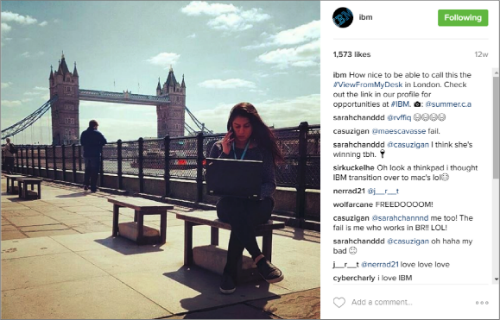This is part of a 4-part series about increasing employee engagement with employee-generated content.
1) Assessing Your Employee Advocacy Opportunities
2) Strategies for launching your employee advocacy program
3) Benefits of an employee advocacy and EGC social media plan
4) Get more content from your employees
Answer this: who knows your company better than anyone else?
Who is working in it every single day and helping to build it into something great?
The answer: your employees.
We’ve spoken a lot about User Generated Content (UGC) before, where your customers create your content for you via various methods like reviews and social media shout-outs, but this time we’re talking about Employee Generated Content (EGC).
Sure, these people have a vested interest in your brand and their place in it, but they’re also the people who understand your core values best. Plus, research has shown that company experts are trusted 66% of the time.
This means people listen to them.
This means people trust them, which is incredibly valuable in this era of authentic content.
And it’s an incredibly powerful tactic. One single employee who shares up to three pieces of brand content a day can add up to a whopping 23 million in additional reach over a year – that’s just one employee.
 EGC engages similar industries, as well as salespeople and specialists.
EGC engages similar industries, as well as salespeople and specialists.
Chances are, you’re already implementing EGC to some extent, whether that’s because your employees Tweet from conferences or because of a workplace joke you have circulating on Instagram.
But, let’s face it, you could be doing it better, right?
It’s a mammoth task, though, so where do you even start?
1) Analyze Your Current Usage
If you’re already using a location tag or a specific hashtag to encourage your employees to share content, analyzing this is a good place to start.
Let’s consider your hashtag for a moment (if you have one).
Fire up any social channels where you’ve been promoting this hashtag and determine:
- Which platform has seen the most interactivity with the hashtag – measure shares, likes, and comments
- How popular the hashtag is – has it only be used a couple of times? Is anyone outside the organization using it? Has it been hijacked by another cause entirely?
- Who the most prolific hashtaggers are – are there one or two people who are always sharing content on the hashtag? Is there a specific team that seems to be the most engaged?
Chances are your hashtag will be a bit barren to begin with but that doesn’t mean that things can’t change quickly.
Take IBM as an example.
When they first decided to jump on the EGC bandwagon, less than 0.01% of employees were producing their own videos.
After a month of content launching, though, employees finally started to get in on the action, sharing videos nearly 4,800 times and adding over 3,000 comments. Don’t get discouraged – neither Rome nor employee advocacy can be built in a day.
2) Look at What Content People are Sharing
The next step is to dig a bit deeper into the content that your employees are sharing – or, more importantly, the kind of content your audience is sharing so you can see where your EGC campaign can fit into that.
An easy way to start this part of the process is to document which mediums your EGC campaigns is attracting the most (this will also depend on your most popular platforms) – is it photos on Instagram? Videos on Facebook? Or something else?
Once you’ve determined that, you can move onto the meat of the content, like what exactly people are sharing, where they’re sharing it, and why they’re sharing it.
The focus of the content here is important.
Why?
Because leads developed through employee social marketing convert seven times more frequently than other leads – that’s a whole lot more chances to gain new customers, but you need to know why those conversions are happening.
One of my predictions is that EGC campaigns often revolve around “nerdy” or “geeky” content. Your employees are passionate about the technology your company created or problems your company is trying to solve. By sharing this type of niche content, it will resonate with the people who are experiencing these challenges and are therefore more likely to convert.
Hint: tap into this and let the passion of your employees shine through!
EGC from the following tend to a hit:
- Company events – happy hour at the bar or team bonding exercises
- Trade shows and conferences – photos with customers and content about their wins/successes
- Team wins, whether it’s a personal team win or something bigger for the company
- Geeky and nerdy content that comes from passion for the problems your company is solving

An employee at Zappos shares their lunch break shenanigans using #Zapposculture
Dig out what content is the most popular from your employees and make a note of it.
3) Assess the Common Threads
Finally, you want to assess the themes that run through what your employees are sharing.
These threads will be able to show you what campaigns have the best chance of sticking and being successful.
- Maybe the content revolves around you being a customer-centric company because they relate heavily to customer service or care.
- Maybe the content is more about you being an innovation-centric company, where your employees are sharing thought leadership pieces.
- Or maybe the content is all about you being an employee-centric company, with your people sharing your awesome culture, perks, and benefits.
Let’s go back to IBM for a moment.
Their EGC campaign ties into the latter of the above maybes.
They encouraged their employees to share photos on Instagram of their offices all over the world – whether that’s an exotic beach somewhere far away, a home office, or an activity they’re getting stuck into with fellow employees in the company headquarters.
This lets employees build relationships with their peers, even if they never work face-to-face with them, and gives consumers a chance to catch a behind-the-scenes look at the brand.

IBM’s #ViewFromMyDesk EGC campaign (source)
Not only does this make IBM seem more human (which we crave in this digitally-led age), but it also helps promote the unique company culture.
Why does it work with IBM?
It works because of the platform, the content, and the theme (basically, because they’ve found the sweet spot between all the things we’ve spoken about in this post).
The primary platform used in the campaign is Instagram which, with over 200 million users, is probably used by most IBM employees – a.k.a. They already have access to this platform and use it in their spare time.
It’s easy to share quick content there, especially content that shows an envious lifestyle (isn’t that what Insta is all about?!).
Final Thoughts
In order to create a successful EGC campaign that has tongues wagging all over the world, you first need to determine what your EGC campaign will consist of.
And, to do that, you need to work with what you’ve got.
Assessing your current strategy (if you have one) means analyzing the platforms you’re already posting on, the hashtags your employees are using, and the kind of content they’re putting out there for the world to see.
Once you’ve done that?
In part two of the series, we’ll start putting together an EGC campaign centered by crafting the perfect hashtag so your team can promote it, proudly!
Did this blog spark some new ideas for a new employee-generated content strategy? Click on the button below and we can bounce ideas around for 15-minutes, together.





